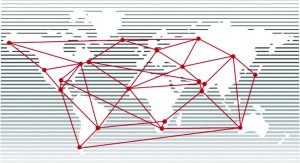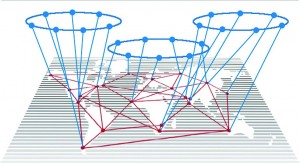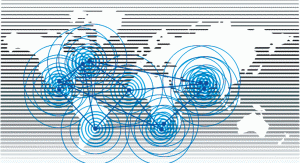Lifecycle of Emergence: Using Emergence to Take Social Innovation to Scale
Despite current ads and slogans, the world doesn’t change one person at a time. It changes as networks of relationships form among people who discover they share a common cause and vision of what’s possible.
This is good news for those of us intent on changing the world and creating a positive future. Rather than worry about critical mass, our work is to foster critical connections. We don’t need to convince large numbers of people to change; instead, we need to connect with kindred spirits. Through these relationships, we will develop the new knowledge, practices, courage, and commitment that lead to broad-based change.
But networks aren’t the whole story. As networks grow and transform into active, working communities of practice, we discover how life truly changes, which is through emergence. When separate, local efforts connect with each other as networks then strengthen as communities of practice, suddenly and surprisingly a new system emerges at a greater level of scale. This system of influence possesses qualities and capacities that were unknown in the individuals. It isn’t that they were hidden; they simply didn’t exist until the system emerges. They are properties of the system, not the individual, but once there, individuals possess them. And the system that emerges always possesses greater power and influence than is possible through planned, incremental change. Emergence is how life creates radical change and takes things to scale.
Since its inception in 1992, The Berkana Institute has been experimenting with the lifecycle of emergence: how living systems begin as networks, shift to intentional communities of practice, and evolve into powerful systems capable of global influence.
Through our work with communities in many different nations, we are learning what’s possible when we connect people across difference and distance. By applying the lessons of living systems and working intentionally with emergence and its lifecycle, we are demonstrating how local social innovation can be taken to scale and provide solutions to many of the world’s most intractable issues—such as community health, ecological sustainability, and economic self-reliance.
Why We Need to Understand Networks
Researchers and social activists are beginning to discover the power of networks and networking. And there is a growing recognition that networks are the new form of organizing. Evidence of self-organized networks is everywhere: from social activists and web-based interest groups to terrorist groups and street gangs. While we now see these everywhere, it is not because they’re a new form of organizing. It’s because we’ve removed our old paradigm blinders that look for hierarchy and control mechanisms in the belief that organization only happens through human will and intervention.
Networks are the only form of organization on this planet used by living systems. These networks result from self-organization, where individuals or species recognize their interdependence and organize in ways that support the diversity and viability of all. Networks create the conditions for emergence, which is how life changes. Because networks are the first stage in emergence, it is essential that we understand their dynamics and how they develop into communities and then systems.
Yet much of the current work on networks displays old paradigm bias. In social network analysis, physical representations of the network are created by mapping relationships. This is useful for convincing people that networks exist, and people are often fascinated to see the network made visible. Other network analysts name roles played by members of the network or make distinctions between different parts of the network, such as core and periphery. It may not be the intent of these researchers, but their work is often used by leaders to find ways to manipulate the network, to use it in a traditional and controlling way.
What’s missing in these analyses is an exploration of the dynamics of networks:
- Why do networks form? What are the conditions that support their creation?
- What keeps a network alive and growing? What keeps members connected?
- What type of leadership is required?
- Why do people become leaders?
- What type of leadership interferes with or destroys the network?
- What happens after a healthy network forms? What’s next?
- If we understand these dynamics and the lifecycle of emergence, what can we do as leaders, activists, and social entrepreneurs to intentionally foster emergence?
What is Emergence?
Emergence violates so many of our Western assumptions of how change happens that it often takes quite a while to understand it. In nature, change never happens as a result of top-down, preconceived strategic plans, or from the mandate of any single individual or boss. Change begins as local actions spring up simultaneously in many different areas. If these changes remain disconnected, nothing happens beyond each locale. However, when they become connected, local actions can emerge as a powerful system with influence at a more global or comprehensive level. (Global here means a larger scale, not necessarily the entire planet.)
These powerful emergent phenomena appear suddenly and surprisingly. Think about how the Berlin Wall suddenly came down, how the Soviet Union ended, how corporate power quickly came to dominate globally. In each case, there were many local actions and decisions, most of which were invisible and unknown to each other, and none of which was powerful enough by itself to create change. But when these local changes coalesced, new power emerged. What could not be accomplished by diplomacy, politics, protests, or strategy suddenly happened. And when each materialized, most of us were surprised. Emergent phenomena always have these characteristics: They exert much more power than the sum of their parts; they always possess new capacities different from the local actions that engendered them; they always surprise us by their appearance.
It is important to note that emergence always results in a powerful system that has many more capacities than could ever be predicted by analyzing the individual parts. We see this in the behavior of hive insects such as bees and termites. Individual ants possess none of the intelligence or skills that are in the hive. No matter how intently scientists study the behavior of individual ants, they can never see the behavior of the hive. Yet once the hive forms, each ant acts with the intelligence and skillfulness of the whole.
This aspect of emergence has profound implications for social entrepreneurs. Instead of developing them individually as leaders and skillful practitioners, we would do better to connect them to like-minded others and create the conditions for emergence. The skills and capacities needed by them will be found in the system that emerges, not in better training programs.
Because emergence only happens through connections, Berkana has developed a four-stage model that catalyzes connections as the means to achieve large-scale change: Name, Connect, Nourish, Illuminate. We focus on discovering pioneering efforts and naming them as such. We then connect these efforts to other similar work globally. We nourish this network in many ways, but most essentially through creating opportunities for learning and sharing experiences and shifting into communities of practice. We also illuminate these pioneering efforts so that many more people will learn from them. We are attempting to work intentionally with emergence so that small, local efforts can become a global force for change.
The Lifecycle of Emergence
Stage One: Networks

Discovering Shared Meaning and Purpose
We live in a time when coalitions, alliances, and networks are forming as the means to create societal change. There are ever more networks and now, networks of networks. These networks are essential for people finding like-minded others, the first stage in the lifecycle of emergence. It’s important to note that networks are only the beginning. They are based on self-interest: people usually network together for their own benefit and to develop their own work. Networks tend to have fluid membership; people move in and out of them based on how much they personally benefit from participating.
Stage Two: Communities of Practice

Developing New Practices Together
Networks make it possible for people to find others engaged in similar work. The second stage of emergence is the development of communities of practice (CoPs). Many such smaller, individuated communities can spring from a robust network. CoPs are also self-organized. People share a common work and realize there is great benefit to being in relationship. They use this community to share what they know, to support one another, and to intentionally create new knowledge for their field of practice.
These CoPs differ from networks in significant ways. They are communities, which means that people make a commitment to be there for each other; they participate not only for their own needs, but to serve the needs of others.
In a community of practice, the focus extends beyond the needs of the group. There is an intentional commitment to advance the field of practice and to share those discoveries with a wider audience. They make their resources and knowledge available to anyone, especially those doing related work.
The speed with which people learn and grow in a community of practice is noteworthy. Good ideas move rapidly among members. New knowledge and practices are implemented quickly. The speed at which knowledge development and exchange happens is crucial because local regions and the world need this knowledge and wisdom now.
Stage Three: Systems of Influence

New Practices Become the Norm
The third stage in emergence can never be predicted. It is the sudden appearance of a system that has real power and influence. Pioneering efforts that hovered at the periphery suddenly become the norm. The practices developed by courageous communities become the accepted standard. People no longer hesitate about adopting these approaches and methods and they learn them easily. Policy and funding debates now include the perspectives and experiences of these pioneers. They become leaders in the field and are acknowledged as the wisdom keepers for their particular issue. And critics who said it could never be done suddenly become chief supporters (often saying they knew it all along).
Emergence is the fundamental scientific explanation for how local changes can materialize as global systems of influence. As a change theory, it offers methods and practices to accomplish the systems-wide changes that are so needed at this time. As leaders and communities of concerned people, we need to intentionally work with emergence so that our efforts will result in a truly hopeful future. No matter what other change strategies we have learned or favored, emergence is the only way change really happens on this planet. And that is very good news.
Note. This article was first published in 2006 by the Berkana Institute.
Principles of Healthy Living Systems
(from cells to organisms, ecosystems to Earth, bodies to businesses)
By Elisabet Sahtouris
1. Self-creation (autopoiesis)
2. Complexity (diversity of parts)
3. Reciprocity of parts in mutual contribution
and assistance
4. Embeddedness in larger holons and dependence
on them (holarchy)
5. Self-reflexivity (autognosis/self-knowledge)
6. Self-regulation/maintenance (autonomics)
7. Input/output exchange of matter/energy/in
formation with other holons
8. Ability to respond and learn from internal and
external stress or other change
9. Transformation of matter/energy/information
with other holons
10. Empowerment/employment of all component parts
11. Communications among all parts
12. Coordination of parts and functions
13. Harmonization of all holon/parts interests
through dialogue
14. Efficiency balanced by resilience
15. Conservation of what works well
16. Creative change of what does not work well
In my scientific worldview the universe is consciousness creating living
systems within itself; thus, ALL living systems are conscious,
intelligent, and can learn. This fundamental assumption, for example,
permits one to see the transparency implications of features 4 and 10.
See more at www.sahtouris.com

[…] Read […]
[…] collaboration among team players. I have been inspired by Margaret Wheatley’s Kosmos article, Lifecycle of Emergence, which stated“when separate, local efforts can be seen as networks then strengthen as communities […]